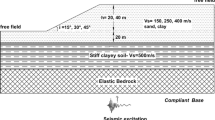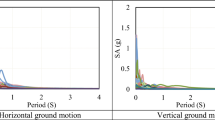Abstract
Ground motion intensity measures are usually used to predict the earthquake-induced displacements in earth dams, soil slopes and soil structures. In this study, the efficiency of various single ground motion intensity measures (scalar IMs) or a combination of them (vector IMs) are investigated using the PEER-NGA strong motion database and an equivalent-linear sliding-mass model. Although no single intensity measure is efficient enough for all slope conditions, the spectral acceleration at 1.5 times of the initial slope period and Arias intensity of the input motion are found to be the most efficient scalar IMs for flexible slopes and stiff slopes respectively.
Vector IMs can incorporate different characteristics of the ground motion and thus significantly improve the efficiency over a wide range of slope conditions. Among various vector IMs considered, the spectral accelerations at multiple spectral periods achieve high efficiency for a wide range of slope conditions. This study provides useful guidance to the development of more efficient empirical prediction models as well as the ground motion selection criteria for time domain analysis of seismic slope displacements.
Similar content being viewed by others
References
Newmark N M. Effects of earthquakes on dams and embankments. Geotechnique, 1965, 15(2): 139–160
Ambraseys N N, Menu J M. Earthquake-induced ground displacements. Earthquake Engineering & Structural Dynamics, 1988, 16 (7): 985–1006
Jibson R W. Regression models for estimating coseismic landslide displacement. Engineering Geology, 2007, 91(2–4): 209–218
Saygili G, Rathje E M. Empirical prediction models for earthquake-induced sliding displacements of slopes. Journal of Geotechnical and Geoenvironmental Engineering, 2008, 134(6): 790–803
Jibson R W. Predicting earthquake-induced landslide displacements using Newmark’s sliding block analysis. Transportation Research Record, 1993, 1411: 9–17
Romeo R. Seismically induced landslide displacements: a predictive model. Engineering Geology, 2000, 58(3–4): 337–351
Watson-Lamprey J, Abrahamson N. Selection of ground motion time series and limits on scaling. Soil Dynamics and Earthquake Engineering, 2006, 26(5): 477–482
Rathje E M, Bray J D. Nonlinear coupled seismic sliding analysis of earth structures. Journal of Geotechnical and Geoenvironmental Engineering, 2000, 126(11): 1002–1014
Bray J D, Travasarou T. Simplified procedure for estimating earthquake-induced deviatoric slope displacements. Journal of Geotechnical and Geoenvironmental Engineering, 2007, 133(4): 381–392
Schnabel P B, Lysmer J, Seed H B. SHAKE—A Computer Program for Earthquake Response Analysis of Horizontally Layered Sites, Earthquake Engineering Research Center, Report No. UCB/EERC-72/12. University of California, Berkeley, 1972
Chiou B, Darragh R, Gregor N, Silva W. NGA project strongmotion database. Earthquake Spectra, 2008, 24(1): 23–44
Vucetic M, Dobry R. Effect of soil plasticity on cyclic response. Journal of Geotechnical Engineering, 1991, 117(1): 89–107
Kramer S L. Geotechnical Earthquake Engineering, Prentice Hall, 1996
Arias A. A measure of earthquake intensity. In: Seismic Design for Nuclear Power Plants, Hansen RJ, ed. Cambridge, MA: MIT Press, 1970, 438–483
Kempton J J, Stewart J P. Prediction equations for significant duration of earthquake ground motions considering site and nearsource effects. Earthquake Spectra, 2006, 22(4): 985–1013
Rathje E M, Abrahamson N A, Bray J D. Simplified frequency content estimate of earthquake ground motions. Journal of Geotechnical and Geoenvironmental Engineering, 1998, 124(2): 150–159
Travasarou T, Bray J D. Optimal ground motion intensity measures for assessment of seismic slope displacements. Pacific Conf. on Earthquake Engineering, Christchurch, New Zealand, 2003
Wang G. A ground motion selection and modification method capturing response spectrum characteristics and variability of scenario earthquakes. Soil Dynamics and Earthquake Engineering, 2011, 31(4): 611–625
Author information
Authors and Affiliations
Corresponding author
Additional information
Gang Wang is an assistant professor in the Department of Civil and Environmental Engineering at Hong Kong University of Science and Technology. He is also Director of ASCE Hong Kong Section, and a registered Civil Engineer in California. He received his B.S. and M.S. in Hydraulic Engineering from Tsinghua University, China in 1997 and 2000, respectively, and his Ph.D. in Civil Engineering from University of California, Berkeley, U.S.A. in 2005. He worked as a consulting engineer at Geomatrix Consultants, Oakland, California in 2007–2008. His research interests include geotechnical earthquake engineering, dynamic soil-structure interaction, numerical analysis of geohazards, and micromechanics of heterogeneous materials.
Rights and permissions
About this article
Cite this article
Wang, G. Efficiency of scalar and vector intensity measures for seismic slope displacements. Front. Struct. Civ. Eng. 6, 44–52 (2012). https://doi.org/10.1007/s11709-012-0138-x
Received:
Accepted:
Published:
Issue Date:
DOI: https://doi.org/10.1007/s11709-012-0138-x




